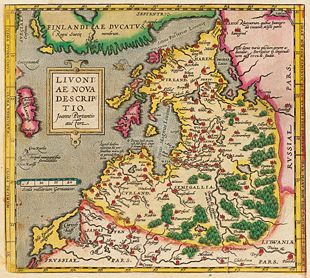Livonian Confederation
| |||||||||||||||||||||||||||||||||||||||||
The Livonian Confederation was a loosely organized confederation in present day Estonia and Latvia ruled by the Order of Teutonic Knights of Livonia and which existed from 1228 to the 1560s. It contained five small states: the Livonian Order, Archbishopric of Riga, Bishopric of Dorpat, Bishopric of Ösel-Wiek, and Bishopric of Courland.
This division was created by Papal Legate William of Modena in 1228 as a compromise between the church and the powerful Livonian Order, both factions led by Germans, after the German knights had conquered and subdued the territories of several indigenous tribes: Finnic-speaking Estonians and Livs, and Baltic-speaking Latgalians, Selonians, Semigallians and Curonians. In theory, one-third of the land was to be controlled by the Order and the remaining two-thirds by the church. But in reality, most of Livonia's territory was controlled by the Order, and conflicts between the Order, the bishops, and the powerful Hanseatic cities were common throughout the existence of the Confederation. To solve internal disputes, the Livonian Diet or Landtag was formed in 1419. The city of Walk was chosen as the site of the Diet. The Diet was composed of members of the Livonian Order, Livonian Bishops, vassals and city representatives.
All five states of the Livonian Confederation ceased to exist during the Livonian War (1558–82). The Livonian Order was dissolved by the Wilno Pact in 1561. The following year, the Livonian Diet decided to ask protection from Sigismund II of Poland (Zygmunt II August) and the Grand Duke of Lithuania. With the end of government by the last Archbishop of Riga William of Brandenburg, Riga became a Free Imperial City and the rest of the territory was split between the Lithuanian vassal states Duchy of Courland and Semigallia and the Duchy of Livonia.
See also
- Kingdom of Livonia
- Üxküll (Ikšķile)
- Northern Crusades
Template:History Timeline of Estonia
Template:Euro-hist-stub
Template:Germany-hist-stub
Template:Estonia-stub
Template:Latvia-hist-stub
de:Livländische Konföderation et:Vana-Liivimaa fr:Confédération Livonienne it:Confederazione della Livonia lv:Livonijas Konfederācija hu:Ó-Livónia nl:Lijflandse Confederatie pl:Konfederacja Inflancka pt:Confederação da Livônia ru:Ливонская конфедерация tr:Livonya Konfederasyonu
Credits
New World Encyclopedia writers and editors rewrote and completed the Wikipedia article in accordance with New World Encyclopedia standards. This article abides by terms of the Creative Commons CC-by-sa 3.0 License (CC-by-sa), which may be used and disseminated with proper attribution. Credit is due under the terms of this license that can reference both the New World Encyclopedia contributors and the selfless volunteer contributors of the Wikimedia Foundation. To cite this article click here for a list of acceptable citing formats.The history of earlier contributions by wikipedians is accessible to researchers here:
The history of this article since it was imported to New World Encyclopedia:
Note: Some restrictions may apply to use of individual images which are separately licensed.
